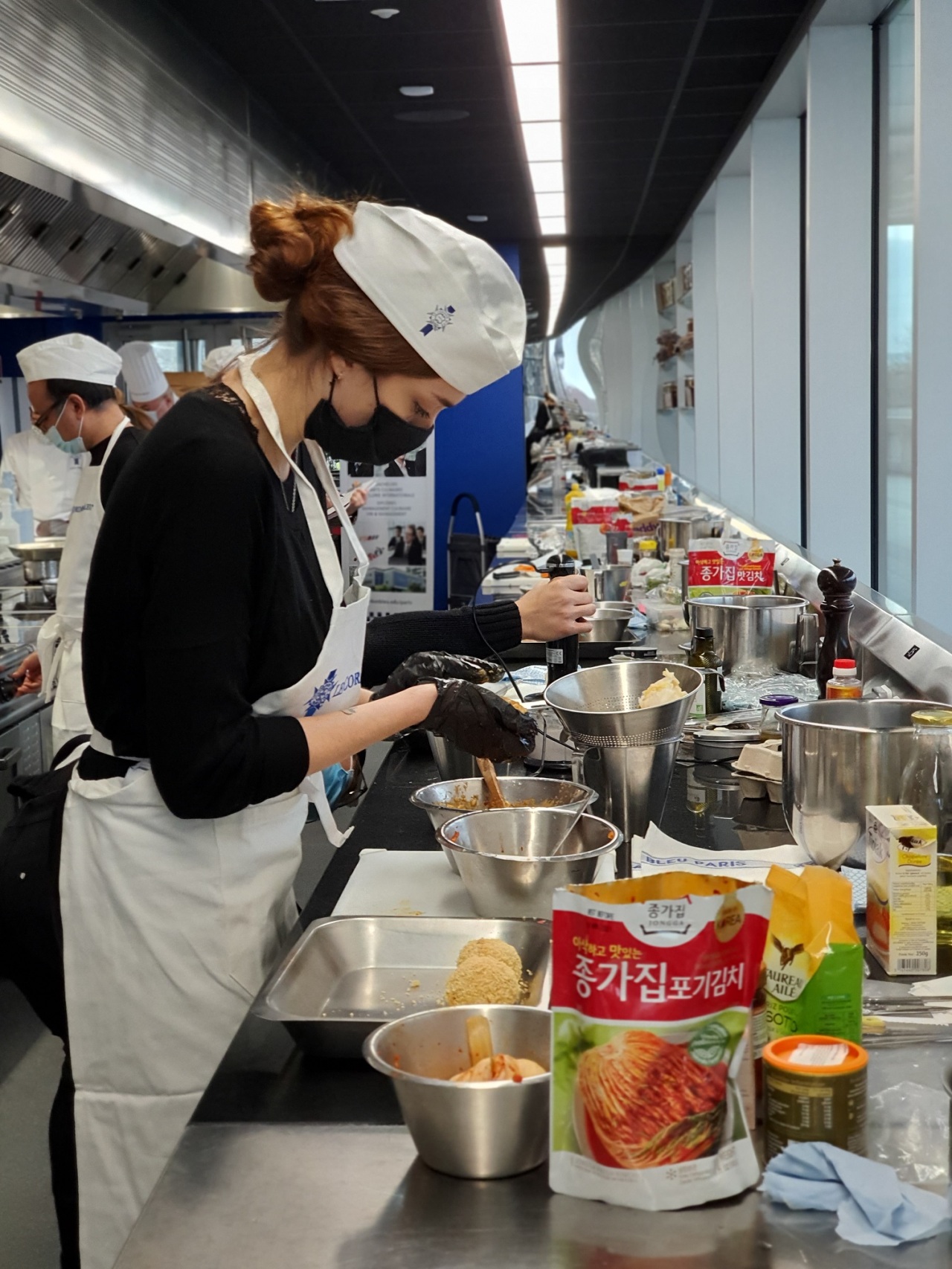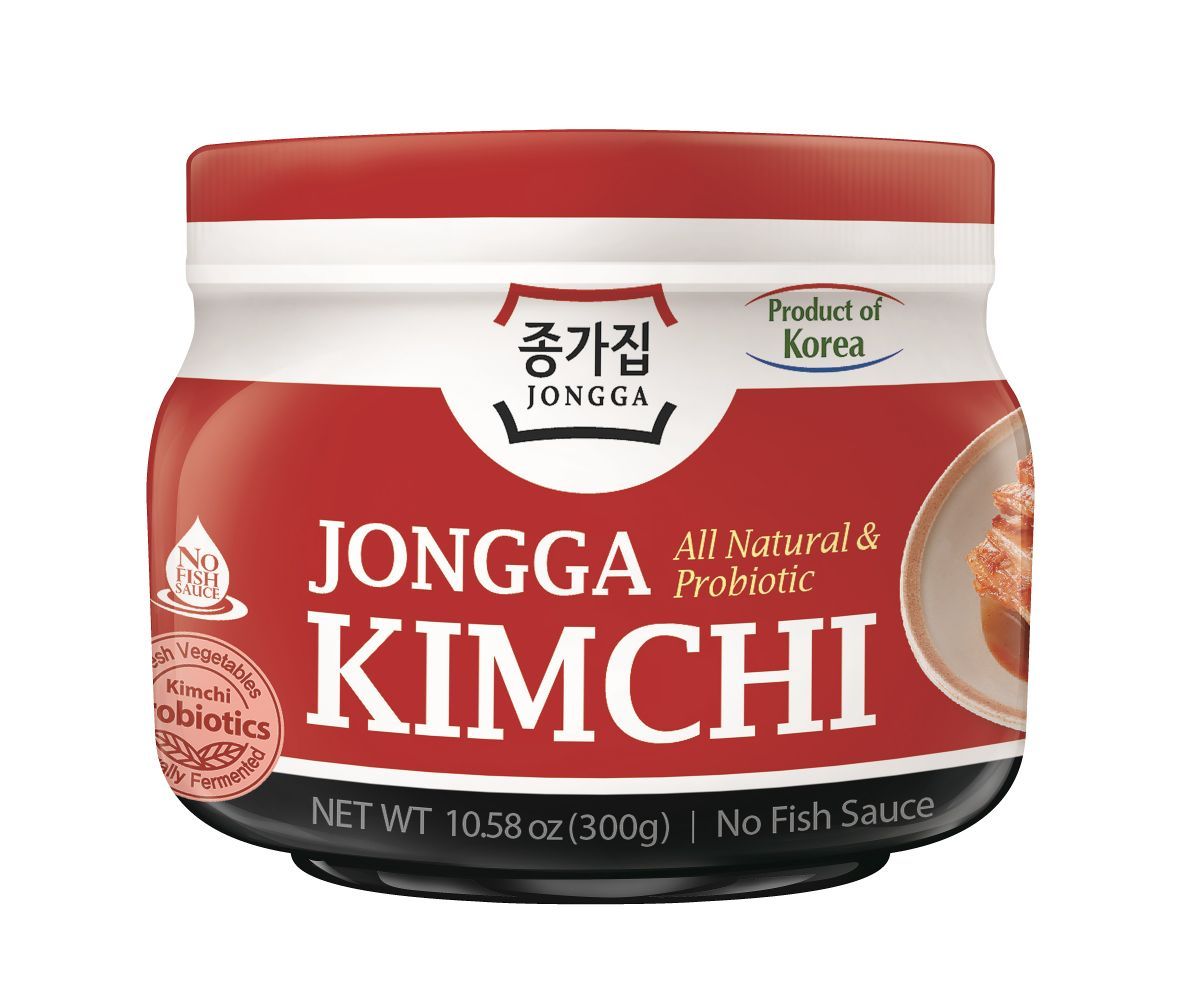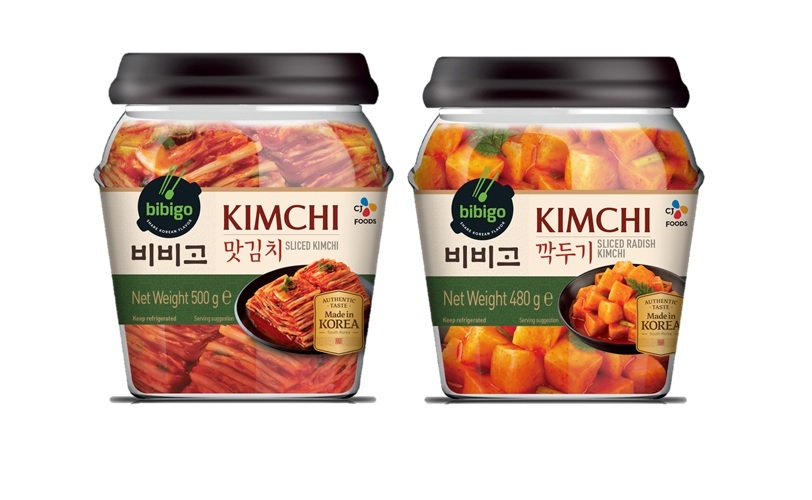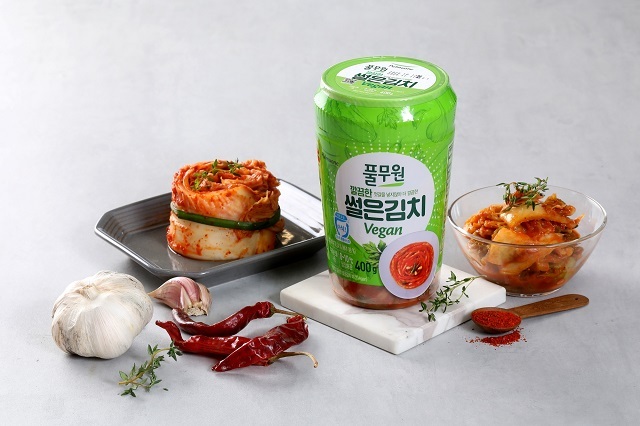 |
A participant cooks at Europe Jongga Kimchi Cookoff Final held at Le Cordon Bleu in France. The event was held jointly by Association Mes Amis and Le Cordon Bleu on Jan. 11. (Daesang) |
Park Kyung-suk, a Korean woman in her 50s, who has been making kimchi for her family for more than 30 years, decided to buy packaged kimchi for the first time last year.
“My two sons moved out so we do not need as much kimchi as we used to,” Park said. “Also, I compared the price of the ingredients that I need to buy with the price of packaged kimchi and found that there is not much difference.”
“I prefer buying small packaged kimchi in convenience stores once in a while, like when I am buying instant noodles,” Jang Eun-ji, a working woman in her 30s said.
As fewer and fewer Koreans opt to go through the laborious process of making large batches of the spicy, fermented cabbage dish at home, which is also known as kimjang, the demand for packaged kimchi has been on the rise.
“It is not that the volume of kimchi that Koreans consume has increased, but our domestic sales increased by 20 percent last year compared to 2017 mainly due to fewer Koreans making kimchi at home,” Lee Seok-ho, a spokesperson at food company Daesang told The Korea Herald. Daesang manages the kimchi brand Jongga.
On top of this, Korea’s export of kimchi reached an all-time high in 2020, on the back of growing global demand for healthier foodstuffs amid the novel coronavirus pandemic.
Outbound shipments of kimchi from January to November last year stood at $131.52 million. It surpassed the previous high of $116.6 million in 2012, the year which saw the highest annual exports before 2019, according to data compiled by the Korea International Trade Association.
 |
Korean general foods company Daesang’s Jongga packaged kimchi product for overseas export (Daesang) |
How did packaged kimchi come about?
Kimchi, which used to be a homemade dish at home, first showed its potential for commercialization when it was canned for Koreans serving in the military. Canned kimchi was sent to Korean soldiers in Vietnam in the late 1960s as well as Korean workers in the Middle East in the 1970s.
Daesang was the first conglomerate to create the packaged kimchi brand Jongga in 1988. The company hired Hwang Hye-seong, a master of Korean royal court cuisine, as its adviser and created the first packaged kimchi product.
In 1989, the company successfully developed its packaging technology, which prevents the package from exploding due to a build-up of carbon dioxide generated during the kimchi’s fermentation process while preserving its taste and quality.
Daesang’s kimchi brand earned a patent for this technology in 1990 and also acquired the Korean Standards certification for the first time in the industry the following year. The certification mark is given to products, services, and agricultural and livestock products that are recognized as industry standards after the Korea Standards Association tests them according to the Industrial Standardization Act.
While packaged kimchi in its early days was only offered in simple plastic bags, it is now available in a variety of forms, including in rectangular plastic containers, plastic cups, as well as jars developed to mimic hangari -- Korean baked-clay jars traditionally used to store kimchi.
 |
CheilJedang’s Bibigo packaged kimchi product for overseas export (CJ CheilJedang) |
Kimchi factories in North America
As the demand for kimchi increases globally, Korean conglomerates have been willing to invest more into expanding global expansion. Local companies are keen to stake a claim in the North American market by establishing factories there.
Jongga, which currently exports its products to over 40 different countries, said it is currently constructing a factory in North America with a plan to start operations in the first quarter this year.
According to Jongga, the company accounts for more than 44 percent of the total export kimchi from Korea. It said that its sales in the US started rising in 2019.
“Just a few years ago, over 90 percent of our customers in the US were Korean Americans. But recently the number of consumers who are not Korean American is showing an upward trend. The packaged kimchi demand also increased further after the COVID-19,” Daesang’s Lee said.
He also highlighted that Korean cultural content on YouTube as well as fans of K-pop bands like BTS and Major League pitcher Ryu Hyun-jin seemed to have influenced the surge in packaged kimchi consumption overseas.
Korean conglomerate CJ’s brand Bibigo also announced its plan to grow its business in North America.
“There is a constant growth in the export and last year it increased by 25 percent from the previous year. The country that showed the biggest increase in sales was the US. Last year, sales in the US grew by 45 percent compared to the previous year,” said an official from the group’s food manufacturing unit, CJ CheilJedang.
CJ CheilJedang’s Bibigo announced on Jan. 12 that it will also develop packaged kimchi products at its new factory whose construction will start in Sioux Falls in South Dakota.
 |
Vegan kimchi product launched by Pulmuone, a South Korean food company, in November last year (Pulmuone) |
New packaged kimchi productsSome Korean companies aim to target a comparably smaller but significant niche market in Korea with unique products.
Pulmuone in 2019 launched a vegan kimchi product for export only, and introduced it into the Korean market last November.
“Vegan kimchi is not only for vegetarians,” a Pulmuone official said. “We think it can be enjoyed by all consumers, including people who occasionally try a vegetarian diet, people who do not like jeotgal, or salt-fermented seafood.”
A local restaurant in Daejeon, which originally only served kimchi as a side dish, started selling it in packages after it went viral for its unique, extra spicy sauce. The product was also introduced on the TV show “Baek Jong-won’s Top 3 Chef King” in 2016 and grew in popularity after many mukbang YouTubers posted challenge videos of eating the kimchi in 2018.
Recently, the restaurant launched a new packaged pakimchi, which is made with tender green onions, or also known as scallions, with the same extra spicy kimchi sauce.
The new product also soon became well-known among spicy food lovers after Korean mukbang YouTubers began posting videos about eating the new product with Chapagetti instant noodles or jajangmyeon, a noodle in black bean sauce.
“I ordered the new pakimchi. It is spicy, but it goes well with jajangmyeon,” mukbang YouTuber G-NI said in a post. Her video, which was not sponsored by the kimchi producer, reached over 799,000 views as of Thursday.
By Song Seung-hyun (
ssh@heraldcorp.com)







![[Herald Interview] 'Trump will use tariffs as first line of defense for American manufacturing'](http://res.heraldm.com/phpwas/restmb_idxmake.php?idx=644&simg=/content/image/2024/11/26/20241126050017_0.jpg)

![[Health and care] Getting cancer young: Why cancer isn’t just an older person’s battle](http://res.heraldm.com/phpwas/restmb_idxmake.php?idx=644&simg=/content/image/2024/11/26/20241126050043_0.jpg)

